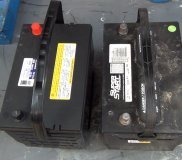Most likely there's a bad connection on one of the battery cables. What I'd like you to do is take a couple of voltage readings before you do anything else. Especially do not wiggle the cables in an attempt at getting things to work. We want to keep it in the defective state so we can identify with certainty the cause of the problem, THEN we'll fix it.
In case you don't know how to use a voltmeter, look at this article first:
https://www.2carpros.com/articles/how-to-use-a-voltmeter
They're using an "auto-ranging" meter here which is an expensive option you don't need. You can find a perfectly fine meter at Harbor Freight Tools for $7.00. Also look at Walmart or any hardware store. I can help you set it up if necessary.
The first measurement is the battery's voltage. Place a meter probe on each battery post, (not the cable clamp attached to it). If the battery is good and fully-charged, it will read close to 12.6 volts.
If that voltage is okay, start by turning on the head light switch. Even though they won't work, we need to have current trying to flow for the next tests to be valid. For the first measurement, place one meter probe on the battery's positive post, and the other probe on the cable clamp attached to it. (The probes will be only 1/2" apart). You should find 0.00 volts because those are two points in the same place in the circuit. If you find anything higher than perhaps a couple hundredths of a volt, list that connection as one that needs to be cleaned and tightened.
Next, take the same reading on the negative post and cable clamp.
I expect to find a very high voltage on one of those tests, possibly even as high as 12 volts. If both a very low, the next suspect is someone cut off the clamp on one of the cables and installed a universal clamp with a strap and two bolts to hold the cable to it. Those are notorious for bad connections. In fact, those clamps were never meant to make a permanent repair. They're designed to get you back on the road until the cable can be replaced later.
The test method is similar. Place one meter probe on the clamp, and the other one on the copper wire strands of that cable. Start with the negative cable. There should be a really fat one that goes to the engine, and a much smaller one that bolts to the body sheet metal. Try to identify each one and take two voltage readings, from the cable clamp with one probe, to each of the cables with the other probe.
If there's that type of replacement clamp on the positive post, do the same measurement there. There should be two cables there too. The fat one goes to the starter. A bad connection on it will only cause the starter to not work. With the entire electrical system being dead, if it's due to a bad connection on that positive cable, it's going to be with the smaller wire. That's the one that feeds the rest of the system.
Also be aware the wire strands in the cables can corrode away under the insulation where you can't see it. Look for white powder close to the cable clamps. A sign of hidden corrosion is the insulation around the wire will be expanded, and may feel "crunchy" when you squeeze it.
These tests are very easy to do, but they're difficult to describe, so let me know if I can clear something up. Let me know what you find with these readings, then we'll figure out where to go next.
Monday, June 5th, 2023 AT 12:45 PM



